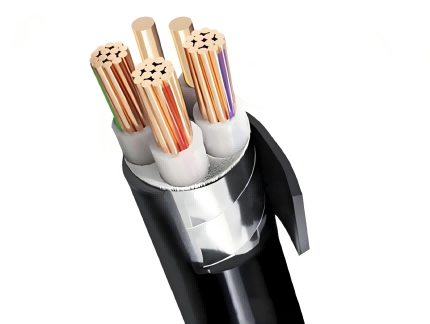To protect the structural integrity and electrical performance of cables and to extend their service life, an armor layer can be added to the outer sheath of the cable. There are generally two types of cable armor: steel tape armor and steel wire armor.
To enable cables to withstand radial pressure, a double steel tape with gap-wrapping process is used—this is known as steel tape armored cable. After cabling, steel tapes are wrapped around the cable core, followed by the extrusion of a plastic sheath. Cable models using this structure include control cables like KVV22, power cables like VV22, and communication cables like SYV22, etc. The two Arabic numerals in the cable type indicate the following: the first “2” represents double steel tape armor; the second “2” stands for a PVC (Polyvinyl Chloride) sheath. If a PE (Polyethylene) sheath is used, the second digit is changed to “3”. Cables of this type are typically used in high-pressure environments, such as road crossings, plazas, vibration-prone roadside or railway-side areas, and are suitable for direct burial, tunnels, or conduit installations.
To help cables withstand higher axial tension, multiple low-carbon steel wires are helically wrapped around the cable core—this is known as steel wire armored cable. After cabling, the steel wires are wrapped with a specific pitch and a sheath is extruded over them. Cable types using this construction include control cables like KVV32, power cables like VV32, and coaxial cables like HOL33. The two Arabic numerals in the model represent: the first “3” indicates steel wire armor; the second “2” indicates a PVC sheath, and “3” indicates a PE sheath. This type of cable is mainly used for long-span installations or where there is a significant vertical drop.
Function of Armored Cables
Armored cables refer to cables that are protected by a metallic armor layer. The purpose of adding armor is not only to enhance tensile and compressive strength and extend mechanical durability, but also to improve electromagnetic interference (EMI) resistance through shielding.
Common armoring materials include steel tape, steel wire, aluminum tape, and aluminum tube. Among them, steel tape and steel wire have high magnetic permeability, providing good magnetic shielding effects, especially effective for low-frequency interference. These materials allow the cable to be directly buried without conduits, making them a cost-effective and widely used solution.
The armor layer can be applied to any cable structure to improve mechanical strength and corrosion resistance, making it ideal for areas prone to mechanical damage or harsh environments. It can be laid in any manner and is particularly suitable for direct burial in rocky terrain. Simply put, armored cables are electrical cables designed for buried or underground use. For power transmission cables, the armor adds tensile and compressive strength, protects the cable from external forces, and even helps resist rodent damage, preventing chewing through the armor that could otherwise disrupt power transmission. Armored cables require a larger bending radius, and the armor layer can also be grounded for safety.
ONE WORLD Specializes in High-Quality Cable Raw Materials
We offer a full range of armoring materials—including steel tape, steel wire, and aluminum tape—widely used in both fiber optic and power cables for structural protection and enhanced performance. Backed by extensive experience and a rigorous quality control system, ONE WORLD is committed to providing reliable and consistent material solutions that help improve the durability and overall performance of your cable products.
Feel free to contact us for more product information and technical support.
Post time: Jul-29-2025


